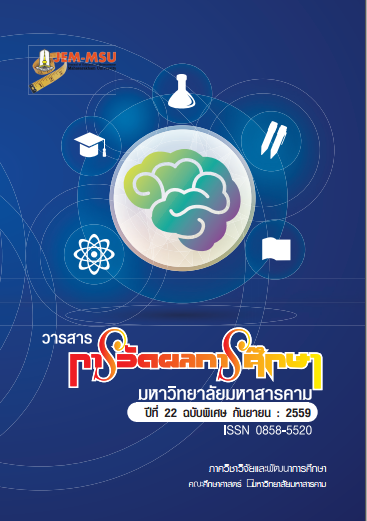Psychosocial Factors Affecting on Work Competency of the Supporting Staffs in Mahasarakham University
Main Article Content
Abstract
This research aimed to study the psychosocial factors related to the working competency
of the supporting staffs of Mahasarakham University and create the predicted equation.
Research samples were 322 staff members, were retrieved by using the Stratified Random
Sampling technique. The research instrument was three past working competency of the
supporting staffs Past 1 status the checklist measurement Past 2 work competency test the
rating scale measurement on with 30 item a discriminating power (rxy) ranged from 0.31 to
0.66 with a reliability 0.91. Past 3 Psychosocial Factors test the rating scale measurement on
with 60 item 6 side namely, personality (P1) a discriminating power (rxy) ranged from 0.35 to
0.61 with a reliability 0.78. boredom (P2) a discriminating power (rxy) ranged from 0.35 to 0.51
with a reliability 0.75. self -efficacy (P3) a discriminating power (rxy) ranged from 0.33 to 0.55
with a reliability 0.85. personal needs in work (P4) a discriminating power (rxy) ranged from
0.30 to 0.58 with a reliability 0.71. organizational environment (P5) a discriminating power (rxy)
ranged from 0.39 to 0.62 with a reliability 0.84 and organizational culture (P6) a discriminating
power (rxy) ranged from 0.30 to 0.68 with a reliability 0.88. Statistics used in data analysis
were mean, S.D. Pearson’s Product-Moment Correlation and Multiple Regression Analysis.
The results of the research were as below.
The predicted factors had a correlation coefficient (R) to the work competency
of the supporting staff of Mahasarakham University was namely, personality (P1) self -efficacy
(P3) organizational environment (P5). The predicted factors had a correlation coefficient (R2)
43 percent and could be described as a predicted equation as described as follows:
Raw Score Equation
Y′ = .48 + .49 P1 + .31 P3 + .13 P5
Standard Score Equation
Z′Y = .35 Z1 + .37 Z3 + .14 Z5
Article Details
The content and information contained in the published article in the Journal of Educational Measurement Mahasarakham University represent the opinions and responsibilities of the authors directly. The editorial board of the journal is not necessarily in agreement with or responsible for any of the content.
The articles, data, content, images, etc. that have been published in the Journal of Educational Measurement Mahasarakham University are copyrighted by the journal. If any individual or organization wishes to reproduce or perform any actions involving the entirety or any part of the content, they must obtain written permission from the Journal of Educational Measurement Mahasarakham University.


